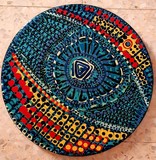03 November, 2005
- WESTERN ARTWORK By Denny Karchner
- 3,302 Views
- 17 Comments
PENCIL TECHNIQUES FOR FUR AND ETC-PART II

For those of you who may have not read PART I of this pencil technique tutorial it is titled PENCIL TECHNIQUES FOR FUR AND ETC in this forum. You might want to go back and read it first. For those of you who have, continue on.
Now let the drawing begin. First find a piece of clean scrap of paper to lay your drawing hand on. I usually use the enlarged copy of my reference for this. This is to keep you from smearing your transferred outlines and your artwork as you go. I am right handed so I almost always start my drawings in the upper left-hand corner and work to the lower right corner. Sometimes, depending on the subject, I will start on the main person or animal first, which is usually in the middle of the drawing area. By doing the main item first, you can judge how strong or how "pushed back" you want to do your other elements or background. There are always exceptions. Trial and error is the norm in the art world. In this case I am starting with the main element, the wolf. There isn't much background in this piece so I will let the background till last.
I usually use drawing pencils in the 2B to 6B range. I always have a good pencil sharpener real close by. I sharpen my pencils constantly. If you want good detail, it is almost a must.

